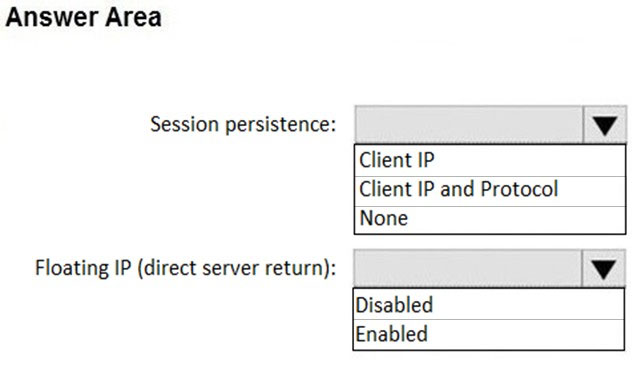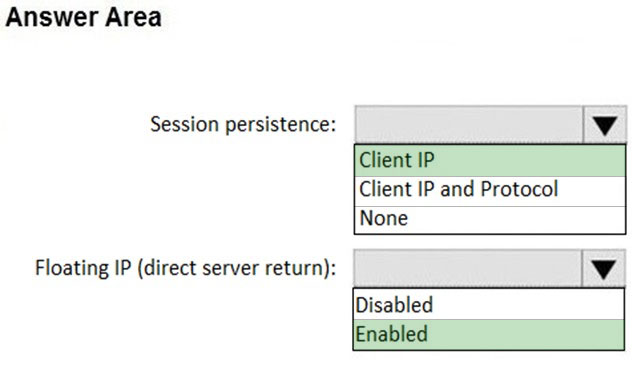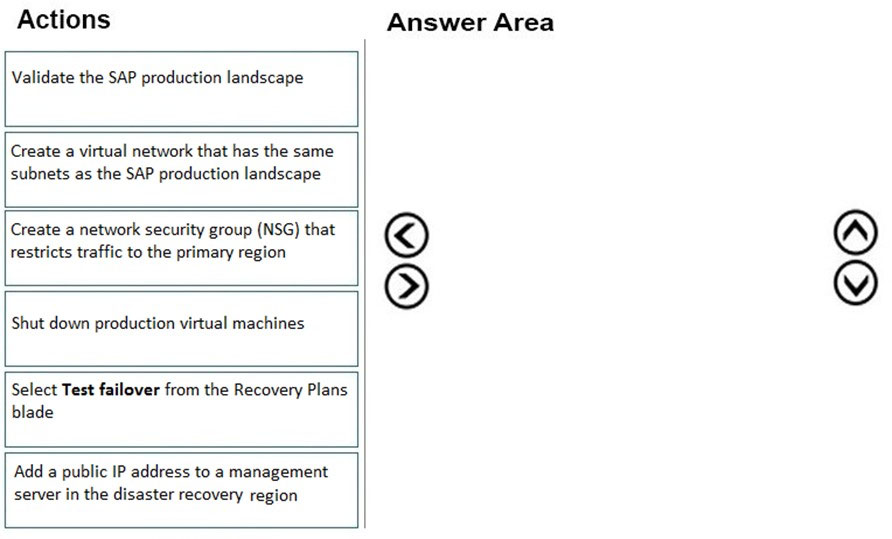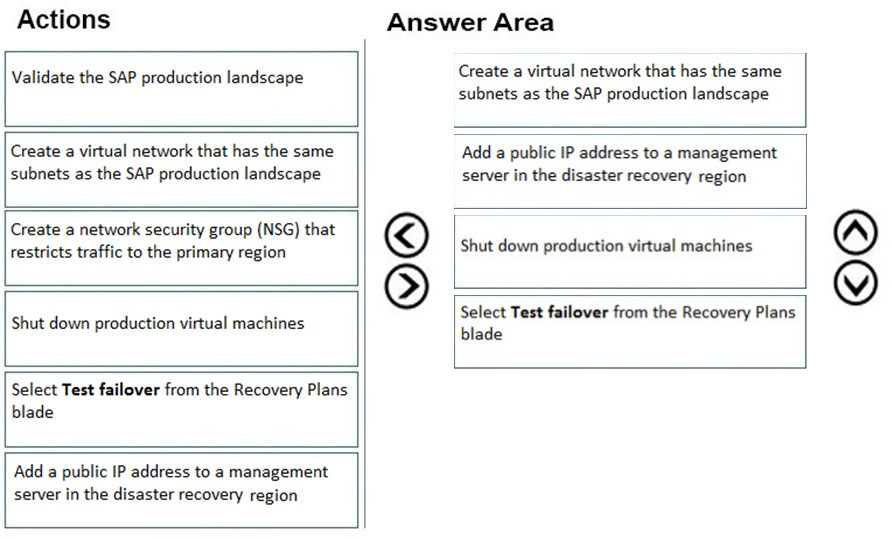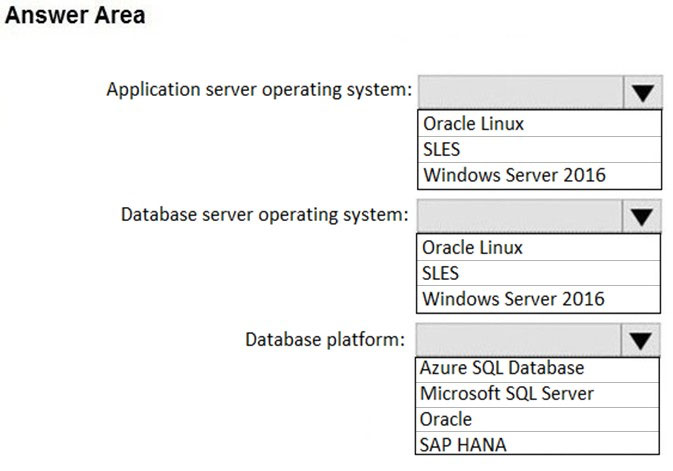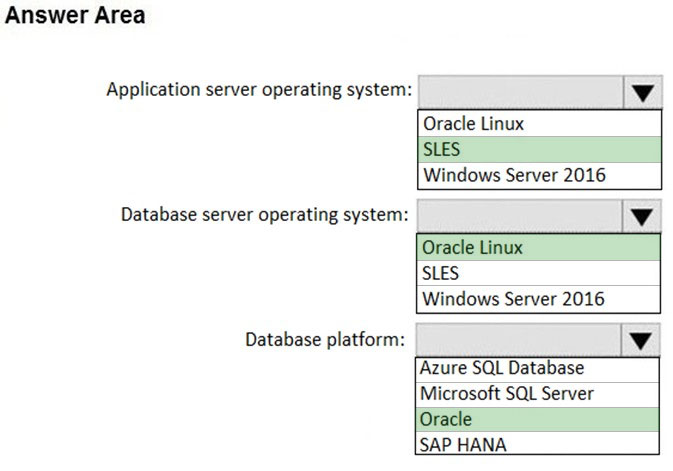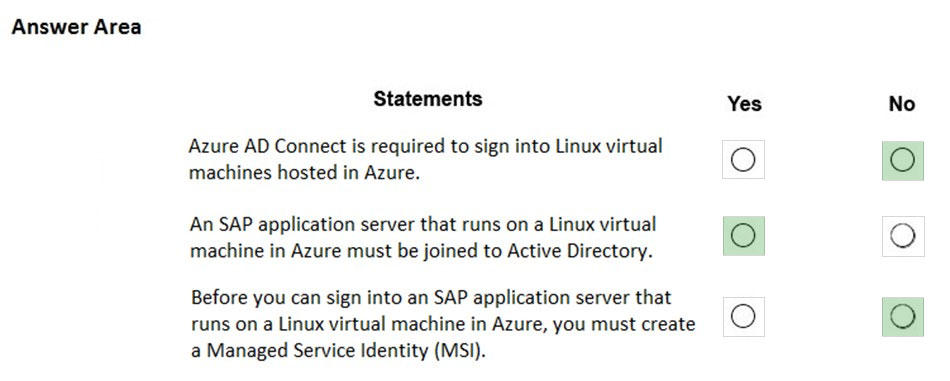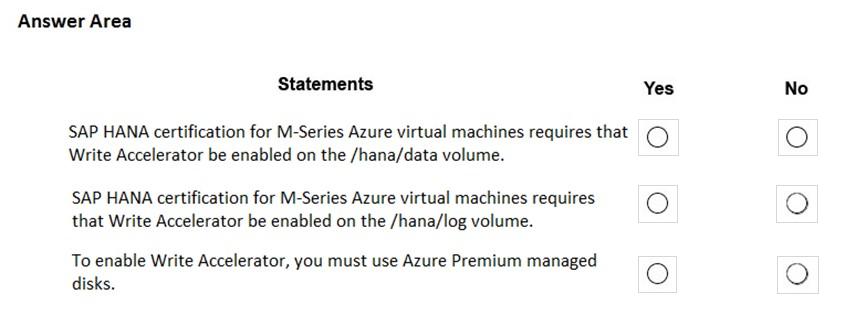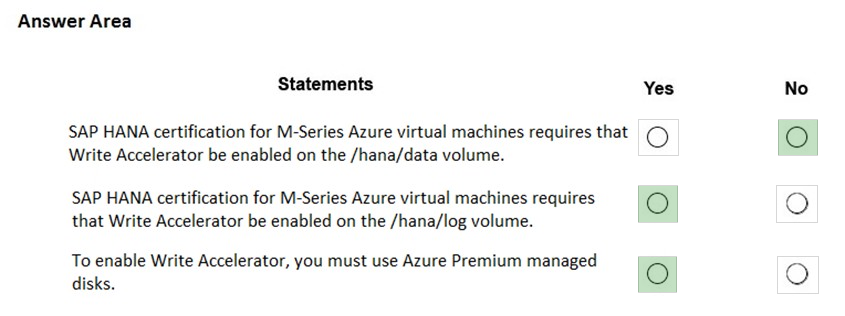AZ-120 Mock Test Free – 50 Realistic Questions to Prepare with Confidence.
Getting ready for your AZ-120 certification exam? Start your preparation the smart way with our AZ-120 Mock Test Free – a carefully crafted set of 50 realistic, exam-style questions to help you practice effectively and boost your confidence.
Using a mock test free for AZ-120 exam is one of the best ways to:
- Familiarize yourself with the actual exam format and question style
- Identify areas where you need more review
- Strengthen your time management and test-taking strategy
Below, you will find 50 free questions from our AZ-120 Mock Test Free resource. These questions are structured to reflect the real exam’s difficulty and content areas, helping you assess your readiness accurately.
HOTSPOT - You plan to deploy a highly available ASCS instance to SUSE Linux Enterprise Server (SLES) virtual machines in Azure. You are configuring an internal Azure Standard Load Balancer for the ASCS instance. How should you configure the internal Standard Load Balancer? To answer, select the appropriate options in the answer area. NOTE: Each correct selection is worth one point. Hot Area:
After you answer a question in this section, you will NOT be able to return to it. As a result, these questions will not appear in the review screen. You deploy SAP HANA on Azure (Large Instances). You need to back up the SAP HANA database to Azure. Solution: You configure DB13 to back up directly to a local disk. Does this meet the goal?
A. Yes
B. No
You have an Azure subscription. You plan to deploy a virtual machine named VM1 that will have the following configurations: • Data disk size: 4 TB • Generation: Generation 2 • Data disk type: Ultra disk • Data disk encryption type: Double encryption VM1 will host the SAP global transport directory in a volume on the data disk. You need to ensure that you can replicate VM1 by using Azure Site Recovery. Which configuration should you change?
A. generation
B. data disk type
C. data disk encryption type
D. data disk size
You plan to deploy a high availability SAP environment that will use a failover clustering solution. You have an Azure Resource Manager template that you will use for the deployment. You have the following relevant portion of the template.What is created by the template?
A. a zone-redundant public IP address for the internal load balancer
B. a zone-redundant frontend IP address for the internal Azure Basic Load Balancer
C. a zone-redundant frontend IP address for the internal Azure Standard Load Balancer
D. a zonal frontend IP address for the internal Azure Standard Load Balancer
You plan to deploy an SAP production landscape on Azure. You need to estimate how many SAP operations will be processed by the landscape per hour. The solution must minimize administrative effort. What should you use?
A. SAP Quick Sizer
B. SAP HANA hardware and cloud measurement tools
C. SAP S/4HANA Migration Cockpit
D. SAP GUI
You have an on-premises SAP Enterprise Central Component (ECC) landscape that is hosted on servers that run Windows Server and uses an Oracle database. You need to migrate the landscape to SAP S/4HANA on Azure virtual machines. The solution must minimize downtime. What should you use?
A. Azure Site Recovery
B. Software Update Manager (SUM)
C. Software Provisioning Manager (SWPM)
D. Azure Migrate
You have an Azure subscription. The subscription contains a virtual machine named VM1 that runs SAP HANA and a user named User1. User1 is assigned the Virtual Machine Contributor role for VM1. You need to prevent User1 from placing VM1 in the Stopped (deallocated) state. User1 must be able to restart the operating system on VM1. What should you do?
A. Create a resource lock on VM1.
B. Assign an Azure Policy definition to the resource group that contains VM1.
C. Assign User1 the Virtual Machine User Login role for VM1.
D. Configure the Desired State Configuration (DSC) extension on VM1.
You have an on-premises SAP NetWeaver deployment that uses Windows Server 2016 and Microsoft SQL Server 2016. You need to migrate the deployment to an Azure virtual machine that runs Windows Server 2016 and has Microsoft SQL Server 2019 installed. Which migration method should you use?
A. lift-and-shift
B. Azure Migrate
C. classical SAP Database Migration Option (DMO)
D. heterogeneous SAP classical migration
HOTSPOT - You plan to deploy a highly available SAP NetWeaver system to Azure virtual machines on SUSE Linux Enterprise Server (SLES) for SAP Applications. You need to configure a load balancer that will be deployed in front of the ABAP Central Services (ASCS) tier. The solution must minimize the number of required load balancing rules. What should you configure? To answer, select the appropriate options in the answer area. NOTE: Each correct selection is worth one point.
DRAG DROP - You have an SAP environment on Azure. You use Azure Site Recovery to protect an SAP production landscape. You need to validate whether you can recover the landscape in the event of a failure. The solution must minimize the impact on the landscape. Which four actions should you perform in sequence? To answer, move the appropriate actions from the list of actions to the answer area and arrange them in the correct order. Select and Place:
You have 100 Azure virtual machines that host SAP workloads and have the SAP Host Agent and the SAP Adaptive Extensions installed. You plan to deallocate the virtual machines during non-business hours. You need to change the managed disk type of the virtual machines when they are deallocated. The solution must minimize administrative effort. What should you use?
A. SAP Information Lifecycle Management (ILM)
B. SAP Landscape Management (LaMa)
C. Azure Functions
D. Azure Automation
HOTSPOT - You are planning the deployment of a three-tier SAP landscape on Azure that will use SAP HANA. The solution must meet the following requirements: • Network latency between SAP NetWeaver and HANA must be minimized. • An SAP production landscape on Azure must be supported. • Network performance must be validated regularly. What should you include in the solution? To answer, select the appropriate options in the answer area. NOTE: Each correct selection is worth one point.
This question requires that you evaluate the underlined text to determine if it is correct. You have an SAP environment on Azure that uses Microsoft SQL Server as the RDBMS. You plan to migrate to an SAP HANA database. To calculate the amount of memory and disk space required for the database, you can use _SAP_Quick_Sizer_. Instructions: Review the underlined text. If it makes the statement correct, select “No change is needed”. If the statement is incorrect, select the answer choice that makes the statement correct.
A. No change is needed
B. Azure Migrate
C. /SDF/HDB_SIZING
D. SQL Server Management Studio (SSMS)
You deploy an SAP environment on Azure. Your company has a Service Level Agreement (SLA) of 99.99% for SAP. You implement Azure Availability Zones that have the following components: ✑ Redundant SAP application servers ✑ ASCS/ERS instances that use a failover cluster Database high availability that has a primary instance and a secondary instanceYou need to validate the high availability configuration of the ASCS/ERS cluster. What should you use?
A. SAP Web Dispatcher
B. Azure Traffic Manager
C. SAPControl
D. SAP Solution Manager
HOTSPOT - You plan to implement a highly available, three-tier deployment of an SAP NetWeaver landscape on Azure. The landscape will use SUSE Linux Enterprise Server (SLES). You need to implement the SAP NetWeaver central services (ASCS/SCS) tier. What should you do? To answer, select the appropriate options in the answer area. NOTE: Each correct selection is worth one point.
HOTSPOT - You have an on-premises SAP environment. Application servers run on SUSE Linux Enterprise Server (SLES) servers. Databases run on SLES servers that have Oracle installed. You need to recommend a solution to migrate the environment to Azure. The solution must use currently deployed technologies whenever possible and support high availability. What should you include in the recommendation? To answer, select the appropriate options in the answer area. NOTE: Each correct selection is worth one point. Hot Area:
You need to recommend a solution to reduce the cost of the SAP non-production landscapes after the migration. What should you include in the recommendation?
A. Configure scaling of Azure App Service
B. Migrate the SQL Server databases to Azure SQL Data Warehouse
C. Deallocate virtual machines when not in use
D. Deploy non-production landscapes to Azure DevTest Labs
After you answer a question in this section, you will NOT be able to return to it. As a result, these questions will not appear in the review screen. You plan to migrate an SAP HANA instance to Azure. You need to gather CPU metrics from the last 24 hours from the instance. Solution: You use Monitoring from the SAP HANA Cockpit. Does this meet the goal?
A. Yes
B. No
You have an on-premises SAP environment hosted on VMware VSphere that uses Microsoft SQL Server as the database platform. You plan to migrate the environment to Azure. The database platform will remain the same. You need gather information to size the target Azure environment for the migration. What should you use?
A. the SAP EarlyWatch Alert report
B. Azure Advisor
C. the SAP HANA sizing report
D. Azure Stack Edge
You plan to migrate an SAP ERP Central Component (SAP ECC) production system to Azure. You are reviewing the SAP EarlyWatch Alert report for the system. You need to recommend sizes for the Azure virtual machines that will host the system. Which two sections of the report should you review? Each correct answer presents a complete solution. NOTE: Each correct selection is worth one point.
A. Hardware Capacity
B. Patch Levels under SAP Software Configuration
C. Hardware Configuration under Landscape
D. Database and ABAP Load Optimization
E. Data Volume Management
You have an SAP environment on Azure. Your on-premises network connects to Azure by using a site-to-site VPN connection. You need to alert technical support if the network bandwidth usage between the on-premises network and Azure exceeds 900 Mbps for 10 minutes. What should you use?
A. NIPING
B. Azure Extension for SAP
C. Azure Network Watcher
D. Azure Monitor
You plan to automate a deployment of SAP NetWeaver on Azure virtual machines by using Azure Resource Manager templates. The database tier will consist of two instances of an Azure Marketplace Microsoft SQL Server 2017 virtual machine image that each has 8 TB of RAM. Which task should you include in the templates used to deploy the SQL Server virtual machines?
A. Enable read caching on the disks used to store the SQL Server database log files.
B. Run the SQL Server setup and specify the /ACTION=INSTALL and /SQLMAXMEMORY switches.
C. Enable buffer pool extensions in SQL Server.
D. Run the SQL Server setup and specify the /ACTION=REBUILDDATABASE and /SQLCOLLATION switches.
HOTSPOT - You have an on-premises SAP landscape that uses DB2 databases and contains an SAP Financial Accounting (SAP FIN) deployment. The deployment contains a file share that stores 50 GB of bitmap files. You plan to migrate the on-premises SAP landscape to SAP HANA on Azure and store the images on Azure Files shares. The solution must meet the following requirements: • Minimize costs. • Minimize downtime. • Minimize administrative effort. You need to recommend a migration solution. What should you recommend using to migrate the databases and to check the images? To answer, select the appropriate options in the answer area. NOTE: Each correct selection is worth one point.
HOTSPOT - You have an on-premises SAP NetWeaver deployment that runs SUSE Linux Enterprise Server (SLES). The deployment contains 200 GB of files used by application servers stored in an NFS share. You plan to migrate the on-premises deployment to Azure. You need to implement an NFS storage solution. The solution must meet the following requirements: • Ensure that only the application servers can access the storage. • Support NFS 4.1 • Minimize costs. What should you include in the solution? To answer, select the appropriate options in the answer area. NOTE: Each correct selection is worth one point.
You have an on-premises SAP landscape that is hosted on VMware vSphere and contains 50 virtual machines. You need to perform a lift-and-shift migration to Azure by using Azure Migrate. The solution must minimize administrative effort. What should you deploy first?
A. an Azure Backup server
B. an Azure VPN gateway
C. an Azure Migrate configuration server
D. an Azure Migrate process server
What should you use to perform load testing as part of the migration plan?
A. JMeter
B. SAP LoadRunner by Micro Focus
C. Azure Application Insights
D. Azure Monitor
You deploy an SAP environment on Azure by following the SAP workload on Azure planning and deployment checklist. You need to verify whether Azure Diagnostics is enabled. Which cmdlet should you run?
A. Get-AzureVMAvailableExtension
B. Get-AzVmDiagnosticsExtension
C. Test-AzDeployment
D. Test-VMConfigForSAP
You have an on-premises SAP NetWeaver deployment. The deployment has a DB2 data store that contains a 5-TB SAP database. You plan to migrate the deployment to SQL Server on an Azure virtual machine. You need to optimize the performance of transaction log write operations during the migration. The solution must NOT affect the I/O quota of the virtual machine. What should you do?
A. Place the transaction logs on the temporary disk.
B. Place the transaction logs on a striped volume of Premium SSD disks.
C. Place the transaction logs on an Ultra disk.
D. Enable the write cache for the disk that hosts the transaction logs.
HOTSPOT - For each of the following statements, select Yes if the statement is true. Otherwise, select No. NOTE: Each correct selection is worth one point. Hot Area:
HOTSPOT - You have an Azure subscription. The subscription contains two virtual machines named SQL1 and SQL2 that host a Microsoft SQL Server 2019 Always On availability group named AOG1. You plan to deploy an SAP NetWeaver system that will have a database tier hosted on AOG1. You need to configure networking for SQL1 and SQL2. The solution must meet the following requirements: • Eliminate the need to create a distributed network name (DNN). • Minimize costs. What should you do? To answer, select the appropriate options in the answer area. NOTE: Each correct selection is worth one point.
You deploy an SAP environment on Azure. Your company has a Service Level Agreement (SLA) of 99.99% for SAP. You implement Azure Availability Zones that have the following components: • Redundant SAP application servers • ASCS/ERS instances that use a failover cluster • Database high availability that has a primary instance and a secondary instance You need to initiate failover of the ASCS/ERS cluster. What should you use?
A. SAP Web Dispatcher
B. Azure Traffic Manager
C. SAPControl
D. SAP Solution Manager
You plan to deploy an SAP production landscape that uses SAP HANA databases on Azure. You need to configure the storage infrastructure to support the SAP HANA deployment. The solution must meet the SAP issued requirements for data throughput and I/O. How should you configure the storage?
A. RAID 1
B. RAID 5
C. RAID 6
D. RAID 0
HOTSPOT - You have an on-premises SAP landscape. You plan to deploy SAP HANA on Azure (Large Instances) to the landscape. You need to recommend a networking solution that meets the following requirements: • Ensures low latency between HANA Large Instances and SAP applications • Supports using SAP Solution Manager on-premises How should you recommend configuring the network? To answer, select the appropriate options in the answer area. NOTE: Each correct selection is worth one point.
You have an Azure subscription that contains the resources shown in the following table.You need to download and install operating system updates from SUSE on HLI1. Which two actions should you perform? Each correct answer presents part of the solution. NOTE: Each correct selection is worth one point.
A. Install and configure the SUSE Linux Subscription Management Tool on Server1.
B. Install and configure the SUSE Linux Subscription Management Tool on Server2.
C. Install and configure the SUSE Linux Subscription Management Tool on Server3.
D. Install and configure the SUSE Linux Subscription Management Tool client on Server2.
E. Install and configure the SUSE Linux Subscription Management Tool client on HLI1.
After you answer a question in this section, you will NOT be able to return to it. As a result, these questions will not appear in the review screen. You deploy SAP HANA on Azure (Large Instances). You need to back up the SAP HANA database to Azure. Solution: You create a Recovery Services vault and a backup policy. Does this meet the goal?
A. Yes
B. No
You have an existing SAP production landscape that uses SAP HANA databases. You plan to migrate the landscape to Azure. Which Azure virtual machine series will be Azure supported for the production SAP HANA database deployment?
A. F-Series
B. A-Series
C. M-Series
D. N-Series
You migrate an on-premises instance of SAP HANA to HANA on Azure (Large Instances). You project that you will replace HANA Large Instances with two smaller instances in two years. You need to recommend a solution to minimize SAP HANA costs for the next three years. What should you include in the recommendation?
A. Azure Hybrid Benefit
B. a one-year reservation that has capacity priority
C. a three-year reservation that has instance size flexibility
D. a one-year reservation that has instance size flexibility
You have an SAP HANA on Azure (Large Instances) deployment that has two Type II SKU nodes. Each node is provisioned in a separate Azure region. You need to monitor storage replication for the deployment. What should you use?
A. xfsdump
B. azacsnap
C. rear
D. tar
DRAG DROP - You have an Azure tenant and an SAP Cloud Platform tenant. You need to ensure that users sign in automatically by using their Azure AD accounts when they connect to SAP Cloud Platform. Which four actions should you perform in sequence? To answer, move all actions from the list of actions to the answer area and arrange them in the correct order.
You have an SAP environment that is managed by using VMware vCenter. You plan to migrate the SAP environment to Azure. You need to gather information to identify which compute resources are required in Azure. What should you use to gather the information?
A. Azure Migrate and SAP EarlyWatch Alert reports
B. Azure Site Recovery and SAP Quick Sizer
C. SAP Quick Sizer and SAP HANA system replication
D. Azure Site Recovery Deployment Planner and SAP HANA Cockpit
HOTSPOT - You have two Azure virtual machines that run SUSE Linux Enterprise Server (SLES). You plan to implement a highly available SAP HANA deployment. You need to implement a STONITH block device (SBD) for the planned implementation. What should you use? To answer, select the appropriate options in the answer area. NOTE: Each correct selection is worth one point.
You have an on-premises SAP environment hosted on VMware vSphere. You plan to migrate the environment to Azure by using Azure Site Recovery. You need to prepare the environment to support Azure Site Recovery. What should you deploy first?
A. an on-premises data gateway to vSphere
B. Microsoft System Center Virtual Machine Manager (VMM)
C. an Azure Backup server
D. a configuration server to vSphere
You have an SAP NetWeaver deployment hosted on Azure virtual machines that run SUSE Linux Enterprise Server (SLES) and are configured as a Pacemaker cluster. You need to monitor the deployment by using Azure Monitor for SAP Solutions. What should you install first on the cluster nodes?
A. performance co-pilot
B. PMProxy
C. ha_cluster_provider
D. pcp-pmda-hacluster
You have an SAP landscape that is hosted on VMWare. You plan to migrate an existing SAP landscape to Azure by using Azure Migrate. You need to configure firewall rules to allow access to the Azure Migrate appliance management app. To which port should you provide access?
A. 3900
B. 44368
C. 44400
D. 50014
You have an SAP landscape on Azure. You deploy an SAP Web Dispatcher named web1. You need to confirm that web1 can support 1,500 users. What should you use?
A. Apache JMeter
B. lometer
C. ABAPMeter
D. FIO
After you answer a question in this section, you will NOT be able to return to it. As a result, these questions will not appear in the review screen. You deploy SAP HANA on Azure (Large Instances). You need to back up the SAP HANA database to Azure. Solution: Back up directly to disk, copy the backups to an Azure virtual machine, and then copy the backup to an Azure Storage account. Does this meet the goal?
A. Yes
B. No
DRAG DROP - You have an on-premises network and an Azure subscription. You plan to deploy a standard three-tier SAP architecture to a new Azure virtual network. You need to configure network isolation for the virtual network. The solution must meet the following requirements: • Allow client access from the on-premises network to the presentation servers. • Only allow the application servers to communicate with the database servers. • Only allow the presentation servers to access the application servers. • Block all other inbound traffic. What is the minimum number of network security groups (NSGs) and subnets required? To answer, drag the appropriate number to the correct targets. Each number may be used once, more than once, or not at all. You may need to drag the split bar between panes or scroll to view content. NOTE: Each correct selection is worth one point.
HOTSPOT - You are planning an SAP NetWeaver deployment on Azure. The database tier will consist of two Azure virtual machines that have Microsoft SQL Server 2017 installed. Each virtual machine will be deployed to a separate availability zone. You need to perform the following: • Minimize network latency between the virtual machines. • Measure network latency between the virtual machines. What should you do? To answer, select the appropriate options in the answer area. NOTE: Each correct selection is worth one point.
HOTSPOT - For each of the following statements, select Yes if the statement is true. Otherwise, select No. NOTE: Each correct selection is worth one point. Hot Area:
You plan to deploy a highly available SAP HANA system in a scale-out configuration with standby to Azure virtual machines. You need to implement shared storage volumes by using Azure NetApp Files. What should you create first?
A. a service endpoint
B. a private link
C. a delegated subnet
D. a private endpoint
Access Full AZ-120 Mock Test Free
Want a full-length mock test experience? Click here to unlock the complete AZ-120 Mock Test Free set and get access to hundreds of additional practice questions covering all key topics.
We regularly update our question sets to stay aligned with the latest exam objectives—so check back often for fresh content!
Start practicing with our AZ-120 mock test free today—and take a major step toward exam success!


